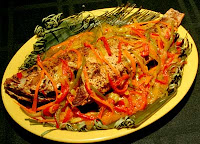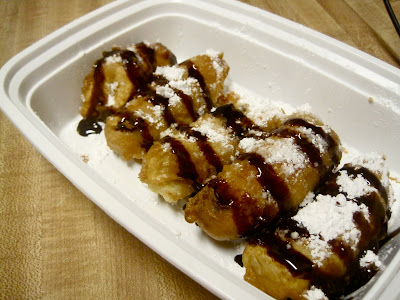Want to make your house smell good? Do not light a candle, or even think about using a Glade plug-in, just cook Moroccan food. The simmering sauce of exotic spices provides the best aromatic.
So why Morocco? No, not because of Casablanca, but because of North Campus Food Mart. Confused? I have a fairly comfortable relationship with the workers of this tiny bodega. They share stories about their family and special order me plum wine, so needless to say, they are great. Two of them are also Moroccan, and their friendliness intrigued me to learn more.
Morocco is located in northern Africa and is borded by the sea and sheltered by the snaking mountains that literally split the country in half. These mountainous areas were once populated by the Berber's, the indigenous people of Morocco, who still compromise most of the population. Yet, these are not the only people that have influenced this exotic cuisine. Morocco is like the doorway of Africa. Imperial rule and trade have traversed the land. The influence of the Arabs, Moors, African, Jewish, French and Spanish have created a cultural stew that is just as flavorful as it's food.
 |
| saffron |
 |
| tajine pot |
No meal is complete without Morocco's most popular drink, mint tea. Making and serving tea in Morocco is an art form. The pouring of the tea is just as important as the preparation of the the tea itself. Traditionally, the tea was made with black tea, steeped with mint leaves, and sweetened with sugar, but the use of green tea has become more popular. Moroccan tea pots have a long, curved spout that allows the tea to be poured from a great height into tiny cups so bubbles are formed. The tea is also traditionally served three times a day and the taste vary according to the time of the day. A Moroccan proverb explains this wonderfully:
"The first glass is a bitter as life,
the second glass is as strong as love,
the third glass is a gental as death."
 |
| Moroccan teapot |
"He who has nothing to die for, has nothing to live for"
Recipe Time:
Guess who came to visit me this week....Kelly! A visit from her was long overdue. To get a taste of Moroccan food I was recommended to visit the The North Market's Firdous Express. They specialize in Mediterranean cuisine, but was told they also usually have Moroccan dishes. I went really hungry, so by the time I remember to take photos I had basically eaten all my Moroccan chicken and Saffron rice. It was delicious. I would definitely go again, and you should go to, because the North Market is an amazing place and has many many good places to eat and shop at. I was suppose to get a recipe from Hafid's (one of my friends from North Campus Food Mart) wife, but he forgot! So I decided just to go with a tradtional dish, tajine with couscous and finished with some mint tea that Kelly made. She also cut the onions and shallots for me because I am a huge baby and I easily cry, and Kelly loves me and does not want to see me cry. Forewarning: start this meal when you ARE NOT hungry because it takes a lot of time and work. Rest assure, your love and devotion with pay off. Not only will your home smell of exotic spices the food is tender, earthy, and extremely flavorful. Definitely a meal to impress friends.
Couscous
serves 4
Ingredients:
- 3tbs butter
- 1/2 cup pine nuts
- 1/2 cup shallots, finely chopped
- 1 1/2 cup couscous
- 1 cinnamon stick
- 1 dried bay leaf
- 1 3/4 cups chicken broth
- 1/4 cup parsley
- lemon zest, salt
Directions:
- Melt the butter in a saucepan and add the shallots and saute until golden.
- Add the couscous, cinnamon stick, and bay leaf. Stir until couscous is slight brown.
- Add broth and bring to a boil.
- Readuce heat, cover, and simmer until liquid is absorbed and couscous is tender, but not mushy.
- Add pine nuts, parsley, lemon zest.
- Flavor with salt.
Chicken Tajine with Almonds and Raisins
serves 3
Ingredients:
- 3 boneless, skinless chicken breasts, cubed
- 2 tbs olive oil
- 1 tsp sal
- 1/2 tsp ground pepper
- 1 tsp cinnamon
- 1/4 tsp powdered ginger
- 1/2 tsp saffron (optional)
- 3 cinnamon sticks
- 2 oz butter
- 1 large onion, diced
- 1/4 cup sugar, divided
- 1 strip lemon peel
- 1/4 lb raisins
- blanched almonds
- fresh mint
Directions:
- Combine the oil and spices in a large bowl.
- Combine chicken and onions to the spices and let marinate for 30 minutes.
- Meanwhile, place the raisins in a small saucepan,cover with water and bring to a boil. Remove the pan from heat and let it stand for 20 minutes.
- Once chicken is done sitting, melt butter in a large saucepan or skillet and cook the chicken and onions until they are lightly browned.
- Add enough water to cover and simmer until chicken is tender.
- Go back to raisins and drain them. Return them to the pan and ladle a little liquid from the chocken and simmer for about minutes.
- Add lemon peel, cinnamon sticks, and half the sugar to the raisins.
- Stir the rest of the sugar into the meet.
- With a slotted spoon, arrange the meat in a bowl. Add the raisins and pour the sauce in the saucepan on the chicken.
- Boil the reaming liquid from the chicken rapidly to reduce it. Ladle some of that sauce on the chicken.
- Brown the almonds in butter.
- Garnish with almonds and mint.
- Serve with couscous.
Moroccan Mint Tea
serves 2
Ingredients:
- 2 teabags of green tea
- Handful of mint leaves
- Sugar
- Boiling water
Directions:
- Put the tea with the boiling water, and steep.
- Add mint leaves and sugar to taste.
 |
| Moroccan tajine on a bed of couscous |

































